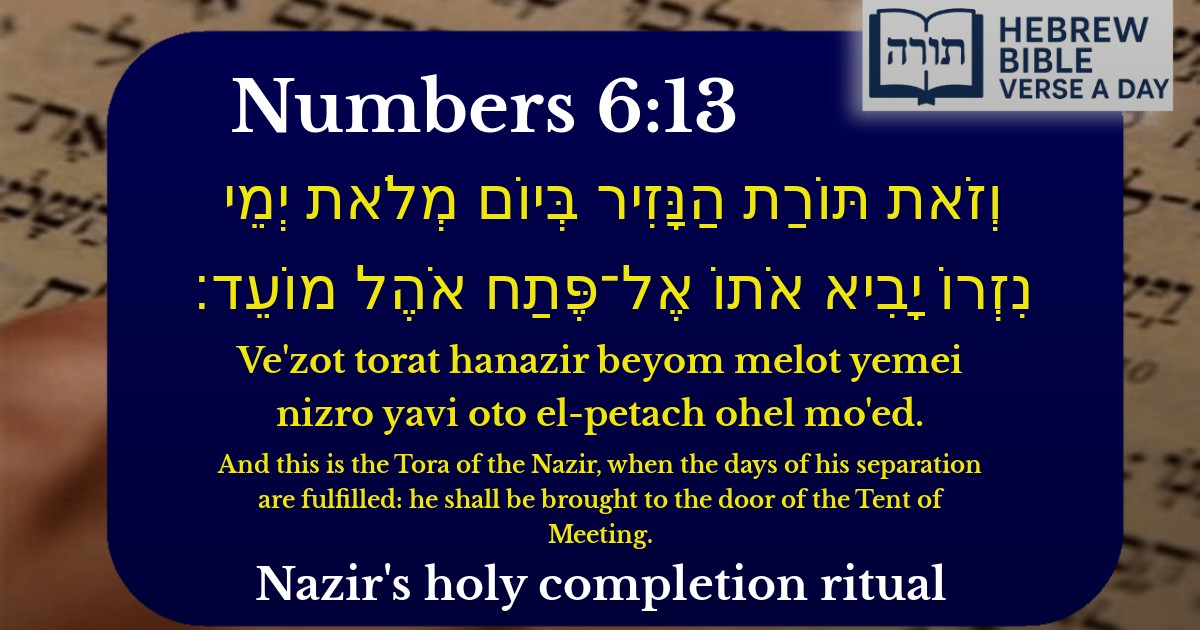Frequently Asked Questions
Q: What is a Nazir in the Torah?
A: A Nazir (or Nazirite) is a person who takes a special vow of dedication to Hashem for a set period of time. During this period, they abstain from wine and grape products, avoid cutting their hair, and must not come into contact with the dead. This is based on the laws in Numbers 6:1-21.
Q: Why does the Nazir bring offerings to the Tent of Meeting?
A: When the Nazir completes their vow, they bring offerings to the Tent of Meeting (later the Temple) as part of the process to conclude their period of nezirut (separation). This includes a sin-offering, burnt-offering, and peace-offering (Numbers 6:13-14). Rashi explains that the sin-offering atones for the fact that the Nazir is now returning to ordinary life after having lived at a higher spiritual level.
Q: What can we learn from the laws of the Nazir?
A: The Nazir teaches us about self-discipline and elevating oneself spiritually. The Talmud (Ta'anit 11a) discusses how temporary abstinence from worldly pleasures can help a person focus on spiritual growth. However, Jewish tradition generally discourages unnecessary asceticism, as the Torah expects us to serve Hashem while living in the world.
Q: Do people take Nazirite vows today?
A: Since the destruction of the Temple, Nazirite vows are generally not practiced, as the Torah requires bringing offerings to conclude the vow (Numbers 6:13-14), which cannot be done without the Temple. The Rambam (Maimonides) discusses in Hilchot Nezirut that if someone does take such a vow today, they would need to observe all the restrictions until the Temple is rebuilt.
Q: Why does the verse say 'he shall be brought' rather than 'he shall come'?
A: The phrasing 'he shall be brought' (in Hebrew 'yavi oto') suggests that others help the Nazir fulfill this mitzvah. Rashi explains this teaches that the community should support those who take on special spiritual commitments. The Midrash (Bamidbar Rabbah 10:11) sees this as an example of how we should encourage and assist others in their service of Hashem.


Introduction to the Nazir's Tora
The verse (Bamidbar 6:13) introduces the laws pertaining to the conclusion of a Nazir's vow, emphasizing the requirement to bring the Nazir to the entrance of the Ohel Moed (Tent of Meeting) upon the completion of their period of nezirut. This marks the transition from a state of heightened sanctity back to ordinary life, requiring specific offerings and rituals.
Rashi's Explanation
Rashi (Bamidbar 6:13) clarifies that the phrase "וְזֹאת תּוֹרַת הַנָּזִיר" ("And this is the Tora of the Nazir") refers to the detailed procedures the Nazir must follow at the end of their vow. He notes that the Nazir is "brought" to the Ohel Moed, implying that others—such as the Kohanim—assist in ensuring the proper fulfillment of the mitzvah. This underscores the communal aspect of the Nazir's return to ordinary status.
Rambam's Perspective
In Hilchos Nezirus (8:1), the Rambam (Maimonides) explains that the Nazir's offerings—including a sin-offering (chatas), burnt-offering (olah), and peace-offering (shelamim)—serve as atonement and mark the formal conclusion of their vow. The Rambam emphasizes that the Nazir's presence at the Ohel Moed is essential, as the offerings must be brought in the sacred space designated for such rituals.
Midrashic Insights
The Midrash (Bamidbar Rabbah 10:12) explores the deeper symbolism of the Nazir's return to the Ohel Moed. It suggests that the Nazir, having temporarily separated from worldly pleasures (such as wine and haircutting), now re-enters the communal spiritual center to reintegrate with the people while maintaining a connection to holiness. The Midrash compares this to a king welcoming back a loyal servant who has completed a special mission.
Talmudic Discussion
The Talmud (Nazir 4b) discusses the phrase "יָבִיא אֹתוֹ" ("he shall be brought"), questioning whether the Nazir must be physically escorted or if this is a figurative instruction. The conclusion is that while the Nazir is responsible for their own arrival, the language implies a communal obligation to support and ensure the proper fulfillment of the vow. This reflects the broader principle that spiritual commitments are not solitary endeavors but involve the broader Jewish community.
Key Themes in the Verse